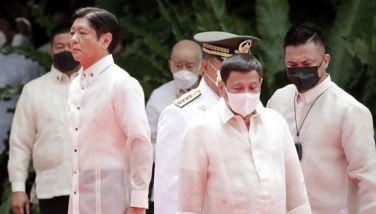SC orders SSS to answer petition vs hike in premiums
MANILA, Philippines - The government was ordered yesterday to answer a petition before the Supreme Court (SC) questioning the 0.6-percentage point hike in premium contributions of Social Security System (SSS) members.
In their first full-court session this year, SC justices agreed to require Malacañang through Executive Secretary Paquito Ochoa Jr., the Social Security Commission and SSS president and chief executive officer Emilio de Quiros to submit a comment on the petition filed last week.
However, the SC deferred action on the petition for a temporary restraining order (TRO).
The petitioners are Anakpawis Rep. Fernando Hicap, Center for Trade Union and Human rights executive director Daisy Arago, National Federation of Labor Unions-Kilusang Mayo Uno represented by Joselito Ustarez and Salvador Carranza.
They alleged that the hike in premium contributions will force minimum wage earners to pay at least P25 more.
Starting this month, the monthly SSS contributions will increase to 11 percent from 10.4 percent.
The Kilusang Mayo Uno said the increase is not necessary to improve the benefits offered to SSS members or to extend the life of the pension fund.
The increase is not for the benefit of SSS members as it would likely “go to the pockets of big capitalists in the form of start-up capital for projects under the government’s public-private partnership program,†they added.
However, De Quiros said the 0.6-point increase in monthly contributions is necessary to prolong the fund’s life and maintain financial viability.
In a television interview, De Quiros said people in other Asian countries shell out higher social security contributions than Filipinos.
The new contribution rate of 11 percent is significantly lower than those of India’s 36.11 percent, Vietnam’s 28.5 percent and Malaysia’s 25.25 percent, he added.
De Quiros said the premium hike was the best option to reduce the pension fund’s unfunded liabilities amounting to about P1.1 trillion.
“We chose to raise members’ contributions rather than cut their benefits,†he said.
“If we don’t do this, the life of SSS will last only until 2039 or 25 years from now, and that members will need to depend on the government to cover payment of benefits.
“Based on our charter, there is government guarantee that for whatever reason SSS can no longer pay retirement and all other benefits, the government will have to fund it and this will depend on the budget. This means every year, the government needs to set a budget for it. But with the increase, the fund’s life span will increase by four to five years.â€
De Quiros said the rate hike will expand the fund’s asset base by P294 billion.
At present, the SSS can only cover 70 percent of the total P3.7 trillion worth of benefits due its more than 30 million members, he added.
Bayan Muna Rep. Neri Colmenares said SSS must first get P90 billion in uncollected premiums from delinquent employers.
Top officials of SSS were also criticized for receiving a total of P9.3 million worth of bonuses at a time when it was considering a hike in contributions.
The government said the hike in premiums was made following consultations with labor and business groups like the Philippine Chamber of Commerce and Industry, Employers Confederation of the Philippines and the Trade Union Congress of the Philippines.
The contributions of SSS members have only been raised twice since 1980 – in 2003 and in 2007.
The ceiling for the monthly salary credit will also be increased from P15,000 to P16,000 beginning this month.
The increase is equivalent to an additional monthly contribution of P6 for every P1,000 increment in the monthly salary credit.
International standards mandate that the life of a pension fund must be at least 70 years to be considered perpetual.
The SSS has been operating for 56 years.
Time for ID processing reduced
The SSS has cut down the processing time of members’ identification (ID) cards to 10 working days from a maximum of four weeks.
SSS IDs under the Unified Multi-purpose Identification System (UMID) use biometric technology and finger-print matching to correctly identify a person.
An active SSS member with at least one monthly contribution, as well as pensioners, may fill out and submit an SSS form E-6 to the nearest SSS branch to apply for the new SSS ID.
UMID applications start with the data capture, or the enrollment of biometric information – such as fingerprints, photo and signature – and encoding of the applicant’s name, address, parents’ names and other demographic data.
To ensure that only one UMID card will be issued to an individual, the member’s fingerprints are compared with other fingerprints in the database during the centralized biometric data matching process.
This is done overnight, after the applications are received at the branches.
Applications with a fingerprint match are immediately investigated by SSS, while those passing the uniqueness check are assigned a Common Reference Number, and then sent for card printing and personalization of the contactless smartchip, which takes three working days.
To ensure good quality, each printed card undergoes visual inspection within one to two working days, depending on the volume of cards, and then forwarded for card packaging, a one-day process that also includes the readability check and data verification of the smartchip. – With Zinnia dela Peña
- Latest
- Trending




























